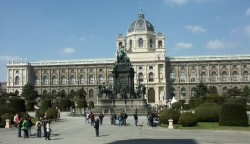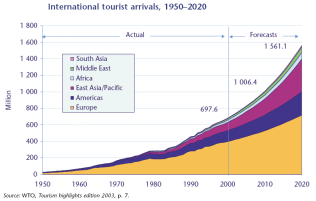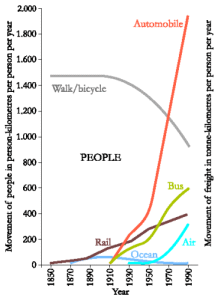|
|
 |
|
|
|
 |
 |
|
|
 |
Context: Tourism in Europe and in the world
|
Key words:
Tourism: definition, types of tourism, industry and economic relevance, trends | |
|
Tourism is the act of travel and visiting places, independent from the purpose. It includes private travel for holiday and recreation purposes but also business travel.
 Definition of tourism Definition of tourism
Definition of the World Tourist Organisation (WTO): Tourists are people who are "travelling to and staying in places outside their usual environment for not more than one consecutive year for leisure, business and other purposes not related to the exercise of an activity remunerated from within the place visited"
In other words: A tourist is a person who goes to another place for private interest or who is sent there (for example by a company), but is not employed at this place.
Business tourists may go to this place for a conference, a workshop or further education. Private tourists may go there for adventure, recreation, education, pilgrimage or other purposes.
 Tourism as industry Tourism as industry
Tourism can also be defined as a service industry with three main foci: |
|
For the definition of tourism the distance between the home of the tourist and the visited place are not relevant.
 Importance of tourism in the economy Importance of tourism in the economy
|
We can define ‘tourism industry’ in a narrow sense, e.g. accommodation establishments, restaurants, cafes, bars and canteens as well as travel agencies and tour operators.
We can also define ‘tourism economy’ in a broader sense and include related sectors such as transport and branches that are dependent on the tourism industry.
Depending on the narrower or wider definition, tourism contributes 4-11% to the gross domestic product (GDP) of the European Union and 4-12% to European employment. Therefore it is an important economic sector.
|
 |
 |
 |
|
1. The Natural History Museum in Vienna: Tourism is a complex industry without sharp borders. Museums, monuments or zoos are only a few examples. Sometimes the main purpose of the attractions was not to make tourists go there, but now they contribute to the tourist industry and services. Please click to enlarge. (45 K)
|
|
 |
 |
|
2. The icecream man: normal business or tourist service?
|
|
 |
 Growth of tourism Growth of tourism
Europe is the world’s most important tourist destination and the most important tourist generating region. The number of international arrivals in Europe rose from 25.3 million in 1950 to 414 million in 2003 and may rise beyond 700 million in 2020. It is estimated that about 20% of tourism comes under the category of business travels.
|
Although tourism always experiences temporary drawbacks for example because of wars (2001 terrorist attack in New York, Iraq war), diseases (SARS in Asia) or crisis in the energy supply (oil crisis in the 1970s), an exponential growth world wide is again expected for the period 2010 – 2020.
|
 |
 |
 |
|
3. International tourist arrivals - development so far and estimates for the future; source: WTO
Please click to enlarge.
|
|
 |
 |
|
4. Worldwide per-capita movement of people, 1850 - 1990. Source: Gilbert (2001); Please click to enlarge.
|
|
 |
 Tourism and aviation Tourism and aviation
Aviation technology became much more advanced during the second world war and thus the potential was available for an economically viable civil aviation industry. The distance travelled by air grew exponentially. Nowadays, people travel on average a little more than 400 km per year by air, more than by train, but clearly less than by car (about 2000 km). What are the reasons for their decisions?
The choice of mode of transport used is part and consequence of the general decisions during holiday planning. When the destination can be freely chosen (as in 80% of the travel) the following factors play a role: distance, travelling costs, quality of accommodation and quality and variety of activities at the destination. Increasing wealth and education increase the likelihood that faster transportation and longer distances are chosen.
|
Low cost airlines have significantly reduced the cost of travel, bringing people geater freedom in choosing destinations and less concern about the price of getting there. The influence of the price can be understood if we consider that 87 % of the Europeans stay within Europe since the cost of transportation is for them of greater importance than other factors.
|
 |
 |
|
5. The consumer’s decision can be illustrated as a hexagon, representing the components involved.
|
|
Outlook
For the future it can be expected that tourism will grow relatively strongly in Asia. The region has a rapidly expanding economy. The growth of demand for services is related to income and in the long run is even higher than that of income. This explains also the growth of tourism over the past 50 years, which may continue in countries such as China or India.
|
However, it does not necessarily mean that the intercontinental travels will strongly rise, but rather interregional travel within Asia.
Furthermore the following trends are expected for Europe by the World Tourist Organisation WTO:
- The number of arrivals might increase but the number of nights spent will do so at lower rates, because of shorter stays; tourism expenditure might only grow as available income does.
|
 |
 |
 |
|
6. Outlook for future worldwide arrivals by region; Source: WTO
Please click to enlarge.
|
|
|
- Long-haul (long distance) arrivals to Europe will be grow at the same rate as globally, but outbound tourism from Europe will grow at a rate twice as high as intra-European outbound tourism. Europe’s attraction as a destination in the world will not decline, but European tourists will become more interested in other regions of the world and will almost certainly reach them by plane.
|
Author:
Elmar Uherek - Max Planck Institute for Chemistry, Mainz
|
|
 |
|







